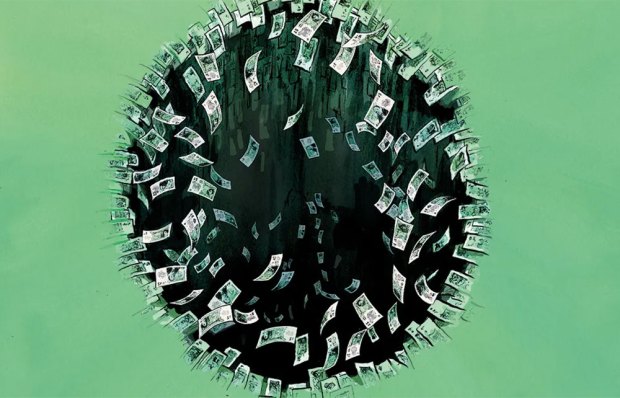The breakaway seven
Sir: ‘In both parties there are fools at one end and crackpots at the other, but the great body in the middle is sound and wise.’ One of the magnificent seven speaking this week? Well, the sentiment is surely present day, but rather they are the words of Churchill in 1913 trying to engineer a centrist national movement from ‘a fusion of the two parties’.
In those days, it was the Conservative and the Liberal parties, but the history of the middle ground since then augurs poorly not just for the breakaway seven, but for those of us who feel disenfranchised by politics. We can argue who currently represents the devil and who the deep blue sea, but right now neither seems an attractive or palatable home.
John Smith
Chesham Bois, Bucks
An afternoon’s reprieve
Sir: Toby Young has done a great deal of good work to challenge the educational establishment. I admire him for that, but on striking school pupils (No sacred cows, 16 February) he needs to cool, man.
Subtlety tends not to be in the nature of the adolescent. It is all or nothing. Sixteen-year-old Greta Thunberg talks with passion about a matter of global significance. Yes, she may have overstated and exaggerated, but that is what 16-year-olds do. Some of her followers in this country are equally passionate; some probably just fancied an afternoon off. How was your behaviour when you were 16, Toby?
Toby says that youngsters who walk out of class cause their teachers real problems in terms of planning lessons. Maybe so, but in my experience most teachers are human. For every teacher who baulked at rearranging their lesson about Boyle’s Law or rescheduling that stunning presentation about the past perfect tense in French reflexive verbs, there were probably ten who privately sighed with relief that they didn’t have that restless bunch of terminally bored, hormonal adolescents to motivate and manage during Friday afternoon. They and their pupils will soon be back in class — day after day after day.
Eric Sinclair (former head teacher)
Aboyne, Aberdeenshire
Scottish ales
Sir: ‘From my limited experience,’ says Bruce Anderson (Drink, 16 February), ‘we Scots are not good at beer. It is something that is only drunk to eke out the whisky.’ Bruce’s experience is indeed limited, and perhaps a visit north is overdue. The Visit Scotland website lists 92 results for ‘craft breweries’, with small independent breweries stretching from Shetland to the Solway Firth. My own current favourites include Brewdog, Cromarty Brewing and Tempest — though my experience is limited, as I have yet to try each and every product available. So far so good, though.
Ian Rankin
Edinburgh
More ghost stations
Sir: As a former Transport for London employee, I was impressed with Patrick West’s article about ghost Tube stations in London (Notes On, February 16). As well as those that he mentioned in the article, there are at least four others. Firstly, besides Down Street and Brompton Road, the Piccadilly Line has a third ghost station, called York Road. Situated between King’s Cross St Pancras and Caledonian Road, it closed in 1932, but its building survives.
Secondly, on the Central Line, there is a ghost station called British Museum between Holborn and Tottenham Court Road. It closed in 1933 and is said to be haunted by the ghost of an ancient Egyptian princess. Its building, sadly, was demolished in 1989. The other two ghost stations are both on the Northern Line; City Road, between Angel and Old Street, and South Kentish Town, between Kentish Town and Camden Town. Both were closed in the 1920s. The article also mentions a ghost station called Mark Street. It was in fact called Mark Lane. I clearly remember walking out of Chiswick Park station many years ago and seeing the name (since covered over) on the station wall.
William Sitwell
Richmond, Surrey
Proliferating ticks
Sir: James Delingpole’s article about his Lyme disease (9 February) is a frightening reminder of the increasing scourge of ticks in Britain. They are a particular menace in the Scottish Highlands, which has been cleansed of sheep and ‘rewilded’ so that the dominant grazer is now deer. While grazing sheep once kept the herbage in control and ‘brushed the hill’ by attracting ticks which were killed by dipping, huge herds of deer now range over great distances, are never dipped and selectively graze, leaving tussocks of overgrown vegetation. This is a perfect medium for the proliferation of ticks. Simply strolling with your family in the wilder parts of the countryside on a summer’s day is rapidly becoming a life-threatening activity.
Philip Walling
Scots Gap, Northumberland
One God
Sir: There is much to commend in Lionel Shriver’s excellent article on forgiveness (‘Without forgiveness, we’re all doomed’, 16 February). But I must correct her on one point where she decries the Old Testament as ‘merciless’. Jesus’s command to love our neighbour as we love ourselves was taken straight from the Jewish scriptures, the book of Leviticus, chapter 19 verse 18. In Christ’s Sermon on the Mount he took this command further by saying, in Matthew chapter 5 verse 18, ‘Love your enemies’. The temptation to fall into the heresy of Marcionism is ever with us. However, a careful reading of the Bible gives witness to this unifying fact: the God of the Old Testament is the God of the New Testament.
Revd Richard Cameron
Scotstoun Manse, Glasgow
Got something to add? Join the discussion and comment below.
Get 10 issues for just $10
Subscribe to The Spectator Australia today for the next 10 magazine issues, plus full online access, for just $10.
You might disagree with half of it, but you’ll enjoy reading all of it. Try your first month for free, then just $2 a week for the remainder of your first year.













Comments
Don't miss out
Join the conversation with other Spectator Australia readers. Subscribe to leave a comment.
SUBSCRIBEAlready a subscriber? Log in